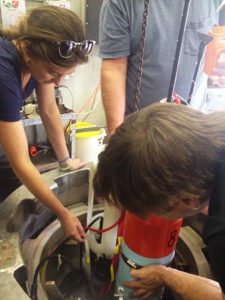The time was 5:55 a.m., and I was wondering whether I should wake up Berkeley Lab engineer Tim Loew, who had nodded off at the table in the middle of assembling a polarizer for the robotic float. I wanted to let him sleep long enough for me to reach for my camera, but he woke up before I got the shot. Maybe next time.
[youtube https://www.youtube.com/watch?v=IMqKR4qDxkg]
Time-lapse video shows researchers setting up the main lab on board the Oceanus. The big plastic “bubble” keeps debris out of the sample processing area. (Credit: Jessica Kendall-Bar).
The original departure time for the Oceanus was 7 a.m., but that was pushed back yesterday when it became clear that not all parts were ready to go. It was clear weeks ago that things were running behind. Parts broke or didn’t work as expected, special screws needed to be ordered, each sample collection tray required 12 hours in a 3-D printer. Team members have been working around the clock, making repeated trips to hardware stores, handing parts off to people as they fly down to San Diego.
“It’s always like this,” said Todd Wood, Berkeley Lab senior engineer. “There was one trip where I was writing software on the way out to the deployment site. I think this trip will be like that.”
The robotic float systems had to be finalized before pressurized water tank tests at the Scripps Institution of Oceanography.
“Once we ballast it, we can’t add anything to it,” said Wood. “We need to keep the mass of the instrument within a few grams, more or less. The CFE (Carbon Flux Explorer) target depth changes by 10 meters with every gram we’re off. So if we’re off by too much it can get to a point where it doesn’t have enough reserve to come back to the surface.”
The last tests were completed and researchers returned from ballast testing at Scripps after 1 a.m. this morning.
“If you plan to do research out on the ocean, expect to deal with problems,” said Phoebe Lam, UC Santa Cruz assistant professor. “Something will always go wrong. Always. And you just have to figure it out.”
Be sure to return to this site once the voyage ends (and more bandwidth is available) for more photos — and videos — from the research effort.

